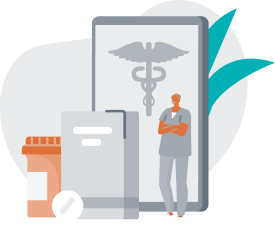What Is a Copay Card and How Does It Work?
In the healthcare industry, affordability remains a key barrier to medication access, particularly in the specialty space.
Patient copay cards, often provided by manufacturers, offer a strategic solution by offsetting out-of-pocket costs for commercially insured patients. For healthcare providers, payors, and infusion pharmacy partners, understanding how these programs work is essential to improving adherence, streamlining reimbursement, and reducing patient drop-off.
Copay cards function by bridging the gap between a patient’s insurance coverage and the full cost of a medication. By absorbing a portion of the copay, these programs support continuity of care, especially for high-cost specialty therapies where cost is often a leading reason for treatment abandonment.
For providers and pharmacy teams, integrating copay card programs into access workflows can drive operational efficiency and optimize outcomes.
Copay Cards in Specialty Care
When it comes to high-cost drugs, copay card programs have become a critical tool for improving medication access, particularly for patients requiring specialty therapies.
These programs, often sponsored by pharmaceutical manufacturers, help bridge financial gaps that can hinder adherence and delay treatment starts.
Leveraging copay solutions through the patient can drive better outcomes while minimizing overhead.
What Is a Copay Card?
A copay card is a manufacturer-sponsored financial assistance tool designed to reduce out-of-pocket costs for commercially insured patients. Applied at the point of sale, these cards lower the patient’s share of a drug’s cost, supporting both affordability and continuity of care.
In the specialty space, where cost is a primary barrier to adherence, copay card integration can:
- Accelerate time to therapy
- Maximize therapy adherence
- Improve refill consistency
- Minimize manual billing intervention
California Specialty Pharmacy works directly with manufacturers and providers to streamline copay support, embedding these tools within access workflows to ensure financial assistance is applied consistently and compliantly per federal regulations.
Types of Copay Cards
Not all discount mechanisms are created equal. While both offer savings, their scope, structure, and strategic value differ:
- Manufacturer Copay Cards: Tied to specific brand-name medications and funded by drug manufacturers. These offer the most significant savings for eligible patients with commercial insurance and are commonly used in specialty pharmacy programs.
- Pharmacy Discount Cards: General savings cards, such as “copay coupons,” which are not affiliated with manufacturers. They apply negotiated rates across multiple drugs but offer less targeted support and lower discounts, typically better suited for generics or uninsured populations.
In specialty care, manufacturer copay cards remain the gold standard for high-cost therapies.
How Copay Cards Work in Specialty Pharmacy
Copay assistance programs are a critical mechanism for managing the high out-of-pocket costs associated with specialty medications.
Designed to streamline access and support adherence, these programs function efficiently behind the scenes through collaboration between manufacturers, pharmacies, and payors.
Streamlined Application at the Pharmacy Level
The operational workflow for copay cards is straightforward and largely automated:
- Eligible patients are enrolled in the manufacturer’s program through online registration or by assistance from provider offices or specialty pharmacy teams.
- At the point of dispensing, the pharmacy submits the primary insurance claim.
- Once the copayment amount is calculated, the copay card is applied as a secondary form of payment, offsetting the patient’s cost automatically within the pharmacy adjudication system.
For healthcare providers and health systems, this process requires minimal staff input. Specialty pharmacies like CSP manage enrollment, coordination, and claims reconciliation to ensure a seamless experience and consistent application of financial support.
Impact on Affordability and Access
Copay cards significantly reduce financial barriers to specialty therapies. In the best-case scenarios, it can lower monthly copayments from hundreds or even thousands of dollars to as little as $0–$25.
Program structures may vary:
- Flat-rate copays (e.g., $10 or $25 per fill)
- Percentage-based discounts
- Maximum benefit caps over a defined period (e.g., $15,000/year)
These discounts are especially valuable for patients with high-deductible plans, commercial insurance gaps, or chronic conditions requiring ongoing therapy.
Copay Card Eligibility
While manufacturer copay programs play a vital role in improving access to specialty medications and prescription drugs, their availability is limited by strict eligibility criteria.
Who Qualifies for Copay Card Support?
Copay card programs are generally designed for patients with commercial or private insurance, including:
- Employer-sponsored plans
- Individual or marketplace policies
- Commercial group health plans
These programs are structured to supplement—not replace—existing insurance coverage. Most require the prescription to be for a branded, FDA-approved therapy deemed medically necessary.
Other common parameters include:
- U.S. residency
- Active insurance coverage at the time of use
- No concurrent participation in federal health programs
Financial screening is uncommon, though some programs may cap annual benefit amounts or limit support based on household income or usage thresholds.
Restrictions on Government-Funded Programs
Manufacturer-sponsored copay cards cannot be used by individuals covered under:
- Medicare (including Part D)
- Medicaid
- TRICARE
- Veterans Affairs
- Other state or federally funded insurance
These exclusions are driven by anti-kickback regulations, which prohibit financial incentives that could influence prescribing behavior in government programs.
For providers and payors, this distinction is critical. High-cost specialty therapies often intersect with federally insured populations, especially in oncology, rheumatology, and rare diseases. In such cases, alternate access pathways must be leveraged.
Copay Card Limitations
Copay card programs offer significant financial relief, but they also come with strict terms that providers, pharmacies, and payors must navigate.
Common Program Caps and Usage Rules
Most manufacturer-sponsored copay cards impose clearly defined parameters, including:
- Maximum benefit thresholds
- Monthly caps (e.g., “up to $500/month”)
- Annual limits (e.g., “maximum $6,000/year”)
- Quantity and refill restrictions
- Limits on the number of fills per month
- Coverage tied to specific formulations or dosages
- Expiration and re-enrollment terms
- Validity typically ranges from 12–24 months
- Renewal may require reapplication through manufacturer hubs
When caps are exceeded or expiration occurs, coverage reverts to the patient’s standard cost share. California Specialty Pharmacy supports proactive tracking and communication to avoid disruptions in therapy.
Legal and Regulatory Compliance
Both state and federal policies impact the scope and application of copay assistance programs:
- Copay accumulator adjustor programs: In some states, insurers may block copay assistance from counting toward deductibles or out-of-pocket maximums, limiting the perceived value of the program for patients.
- Federal Anti-Kickback Statute: This law prohibits manufacturers from offering financial incentives that could influence therapy selection within federally funded insurance programs (e.g., Medicare, Medicaid). As a result, copay cards are not valid for beneficiaries of government-sponsored coverage.
Copay Cards as a Strategic Access Tool
Copay card programs play a critical role in enabling access to high-cost specialty medications, particularly within commercial insurance markets. When integrated effectively, these programs reduce financial barriers, improve medication adherence, and support continuity of care for patients managing complex conditions.1
For health systems, specialty providers, and payers, maximizing the impact of copay assistance requires operational precision and regulatory awareness. From program eligibility screening to benefit limit tracking and refill coordination, seamless execution is key to ensuring long-term access and optimizing outcomes.
California Specialty Pharmacy partners with stakeholders across the healthcare ecosystem to simplify and streamline copay support. Through our coordinated access services and payer-aligned strategies, we help ensure that every eligible patient receives the financial support available, while protecting program compliance and operational efficiency.
Frequently Asked Questions (FAQ):
What does a copay card do?
Copay cards reduce the patient’s out-of-pocket costs for brand-name medications, helping providers initiate therapy and maintain adherence without financial delays.
Why do drug companies offer copay assistance?
Copay cards are part of manufacturer-sponsored access programs designed to improve therapy uptake, reduce abandonment at the pharmacy, and drive brand loyalty among commercially insured populations.
Can Medicare or Medicaid patients use copay cards?
No. Federal anti-kickback regulations prohibit the use of manufacturer copay assistance for patients with government-funded insurance, including Medicare, Medicaid, TRICARE, and VA coverage.
What happens when copay card benefit limits are reached?
Once a program’s monthly or annual cap is met, the patient assumes full responsibility for the copay unless alternative funding is secured.
References:
1. What to know about manufacturer copay cards. Medical News Today. 2024 Jun. https://www.medicalnewstoday.com/articles/manufacturer-copay-cards#summary
Legal Disclaimer:
The content provided on this blog is for informational purposes only and is not intended to serve as medical advice, diagnosis, or treatment. While we make every effort to provide accurate and up-to-date information, the details shared here should not be considered a substitute for professional medical consultation or advice.
By accessing this blog, you agree to hold harmless the author, publisher, and any associated parties from any claims, liabilities, or damages arising from the use or interpretation of this content.
©2025 California Specialty Pharmacy, LLC. All rights reserved.

